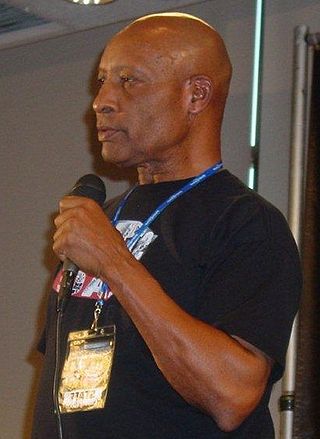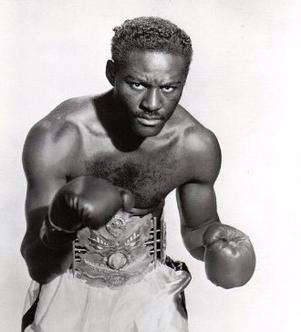
Roberto Durán Samaniego is a Panamanian former professional boxer who competed from 1968 to 2001. He held world championships in four weight classes: Lightweight, welterweight, light middleweight and middleweight. Duran also reigned as the undisputed and lineal lightweight champion and the lineal welterweight champion. He is also the second boxer to have competed over a span of five decades, the first being Jack Johnson. Durán was known as a versatile, technical brawler and pressure fighter, which earned him the nickname "Manos de Piedra" for his formidable punching power and excellent defense.
Aaron Pryor vs. Alexis Argüello, billed as The Battle of the Champions, was a term used by promoter Bob Arum regarding the light welterweight boxing super match between Aaron Pryor and Alexis Argüello on November 12, 1982.

HBO World Championship Boxing is an American sports television series on premium television network HBO. It premiered on January 22, 1973 with a fight that saw George Foreman defeat Joe Frazier in Kingston, Jamaica.

Thomas Hearns is an American former professional boxer who competed from 1977 to 2006. Nicknamed the "Motor City Cobra", and more famously "The Hitman", Hearns's tall, slender build and oversized arms and shoulders allowed him to move up over fifty pounds in his career and become the first boxer in history to win world titles in five weight divisions: welterweight, light middleweight, middleweight, super middleweight and light heavyweight.

Rocco Francis Marchegiano, better known as Rocky Marciano, was an American professional boxer who competed from 1947 to 1955. He held the world heavyweight championship from 1952 to 1956, and remains the only heavyweight champion to finish his career undefeated. His six title defenses were against Jersey Joe Walcott, Roland La Starza, Ezzard Charles (twice), Don Cockell and Archie Moore.

Charles "Chuck" Wepner is an American former professional boxer. He fell just nineteen seconds short of a full fifteen rounds against world heavyweight champion Muhammad Ali in a 1975 championship fight. Wepner also scored notable wins over Randy Neumann and former world heavyweight champion Ernie Terrell. He was also the last man to fight former undisputed world heavyweight champion Sonny Liston.

Richard Steele is an American retired boxing referee who was inducted into the International Boxing Hall of Fame.

Ezzard Mack Charles, known as the Cincinnati Cobra, was an American professional boxer and World Heavyweight Champion, known for his slick defense and precision. Often regarded as the greatest light heavyweight of all time, Charles defeated numerous Hall of Fame fighters in three different weight classes. Charles retired with a record of 95-25-1. He was posthumously inducted into the International Boxing Hall of Fame in the inaugural class of 1990.

Boxing in the 1980s was filled with important fights, events and personalities that shaped the sport. Boxing in the 1980s was shaped by many different situations, such as the continuous corporate battles between the different world sanctioning organizations, the void left by Muhammad Ali as the sport's ambassador and consequent search for a new boxing hero, the continuous presence of Don King as the sport's most famous promoter, the surge of rival promoters as Bob Arum, Butch Lewis and Murad Muhammad, and major rule changes. In 1986, Mike Tyson emerged as a fresh new face in the heavyweight division, which had seen a decline in champion quality level after Ali's retirement and, later on, after longtime WBC ruler Larry Holmes' prime. In addition, the IBF and WBO began operating.
During the 1950s, a couple of relatively new developments changed the world: World War II had only been over for five years when the 1950s began, and television was beginning to make a major impact internationally. In boxing, changes connected to these developments could be seen too, as boxers who fought at the 1940s conflict returned to their homes and many of them were back in the ring. Television producers were in love with sports, which provided the viewer with an opportunity to observe sporting events live, and boxing was not the exception to the rule; many television networks began to feature fights live during the weekends, and the Gillette Friday Night Fights proved to be one of the most popular boxing television series in American history.

Antonio Deon Tarver is an American former professional boxer and boxing commentator. In boxing he competed from 1997 to 2015, and held multiple light heavyweight world championships, including the WBA (Unified), WBC, IBF and Ring magazine titles, as well as the IBO light heavyweight and cruiserweight titles.

Marvin Hagler vs. Thomas Hearns, was a world middleweight championship boxing match between undisputed champion Marvelous Marvin Hagler and challenger Thomas Hearns, the WBC super welterweight champion, who had gone up in weight for the bout. Won by Hagler by third-round knockout, the fight is considered by some to be the greatest three rounds in boxing history, due to its constant action, drama, and violent back-and-forth exchanges.
Donald John Cockell was an English boxer. He fought for most of his career as a light-heavyweight and became the British and European champion at that weight. Later in his career he moved up to heavyweight and held the British and Commonwealth heavyweight titles. He is best remembered for fighting against Rocky Marciano for the world heavyweight championship. Cockell defeated a number of top heavyweights in his career, including Roland La Starza, Harry Matthews, Tommy Farr, Freddie Beshore, Johnny Arthur, Johnny Williams and Uber Bacilieri. In his earlier incarnation as a Light Heavyweight he defeated top contenders such as Nick Barone, Albert Yvel, Lloyd Marshall and Albert Finch, holding regional titles in both weight incarnations.
Aaron Pryor was an American professional boxer who competed from 1976 to 1990. He was a two-time light welterweight world champion, having held the WBA title from 1980 to 1983, and the IBF title from 1984 to 1985. Additionally, he held the Ring magazine title from 1980 to 1983, and the lineal title from 1983 to 1986.
Rocky Marciano fought two celebrated boxing matches with Ezzard Charles. The first match took place on 17 June 1954; and the second on 17 September 1954. The first fight went the distance with Marciano winning on points through a unanimous decision. In the second bout Marciano knocked out Charles in the eighth round.
Anthony Perez was an American boxing referee and judge of Puerto Rican descent. During his career, he refereed many major boxing fights and participated in a number of boxing related documentaries.
Charles "Chuck" Hull was an American ring announcer and sportscaster who worked for more than thirty years in Las Vegas, Nevada, introducing professional boxers to live and television crowds at many non-title and major world championship boxing fights, both amateur and professional ones, many of which were held at the city's Caesar's Palace hotel. Hull was a member of the defunct World Boxing Hall of Fame. Hull was also a broadcaster, participating in shows shown at Las Vegas' KLAS_TV television channel.
The Marvin Hagler vs. Roberto Duran contest was a professional boxing fight which took place on November 10, 1983, at the Caesar's Palace hotel in Las Vegas, Nevada. It was for Hagler's universally recognized IBF, WBA and WBC world Middleweight title. Having knocked out Davey Moore in eight rounds on the previous June 16th to win his third divisional world championship, the WBA world Junior Middleweight one, Duran, a Panamanian, was attempting to become the first four division world champion in boxing history. Hagler, meanwhile, had beaten Alan Minter by third round technical knockout in September of 1980 to win the undisputed world Middleweight title, and, after proposed "super-fight" title defenses against Sugar Ray Leonard and Thomas Hearns failed to take place, was making the eighth defense of that championship, his seven previous defenses all ending in knockout wins for the American champion.
Heavyweight champions Rocky Marciano and Jersey Joe Walcott fought two historic boxing matches in 1952 and 1953. The first fight saw Marciano, the undefeated challenger, take on the world heavyweight champion Jersey Joe in a hard-fought championship fight. The fight culminated in a 13th round knockout scored by Marciano, in a major comeback victory after Walcott stacked up a wide lead throughout the majority of the bout. The fight and the final round were ranked as 1952's fight and round of the year respectively by The Ring, and is considered one of the greatest heavyweight championship bouts of all time.
The Michael Dokes vs. Mike Weaver or, alternately, Mike Weaver vs. Michael Dokes, boxing fights were a pair of fights that occurred in 1982 and 1983 and were for the World Boxing Association's world Heavyweight title. Both fights were considered controversial due to a separate set of situations. They are both among the most widely spoken about heavyweight boxing contests of the 1980s.









